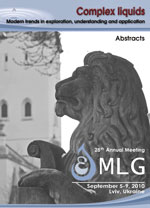Aqueous alkali halide solutions: can osmotic coefficients be explained on the basis of the ionic sizes alone?
Yurii Kalyuzhnyi
We use the AMSA associative mean spherical theory of associative fluids, to study ion--ion interactions in explicit water. We model water molecules as hard spheres with fouro ff-center square-well sites and ions as charged hard spheres with sticky sites that bind to water molecules or other ions. We consider alkali halide salts. The choice of model parametersis based on two premises: (i) The strength of the interaction between a monovalent ion and a water molecule is inversely proportional to the ionic (crystal) diameter . Smaller ions bind to water more strongly than larger ions do, taking into account the asymmetry of the cation-water and anion-water interactions. (ii) The number of contacts an ion can make is proportional to . In short, small ions bind waters strongly, but only a few of them. Large ions bind waters weakly, but many of them. When both a monovalent cation and anion are large, it yields a small osmotic coefficient of the salt, since the water molecules avoid the space in between large ions. On the other hand, salts formed from one small and one large ion remain hydrated and their osmotic coefficient is high. The osmotic coefficients, calculated using this model in combination with the integral equation theory developed for associative fluids, follow the experimental trends, including the unusual behavior of cesium salts.



